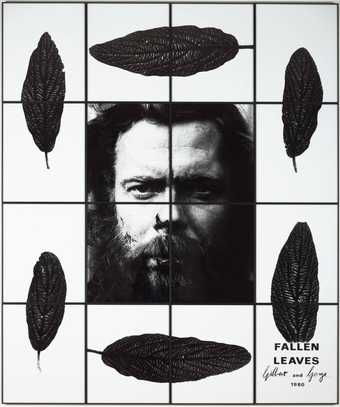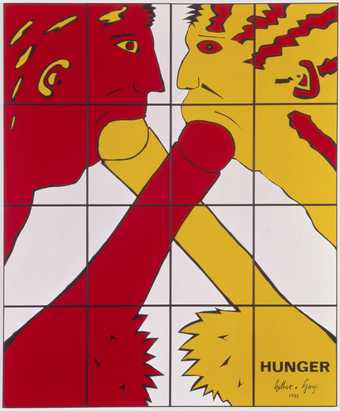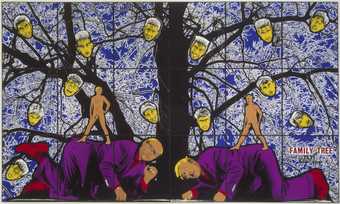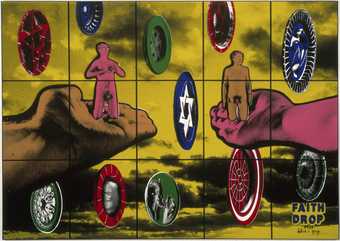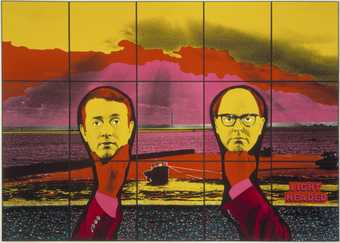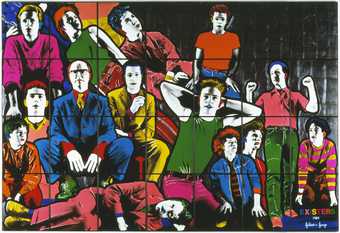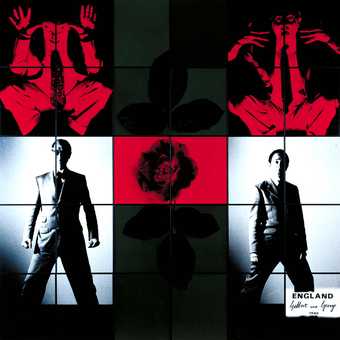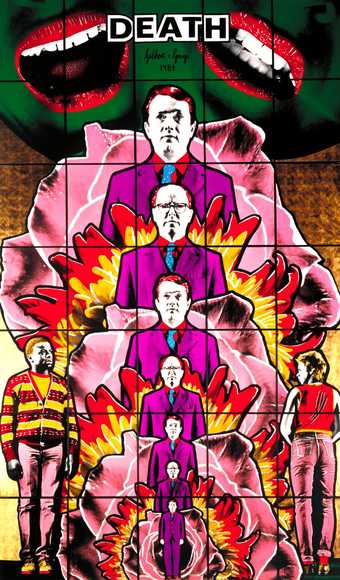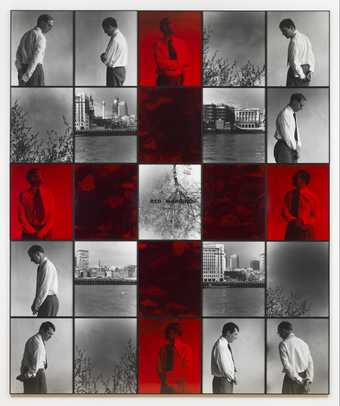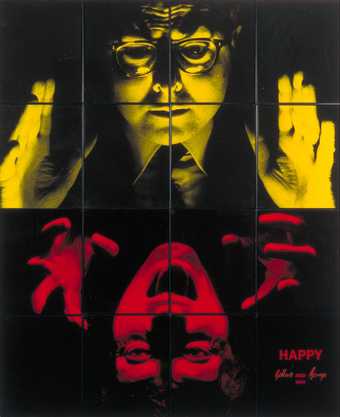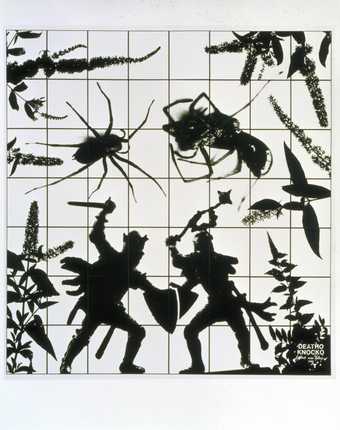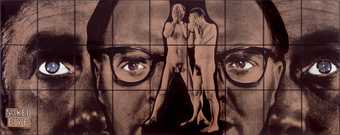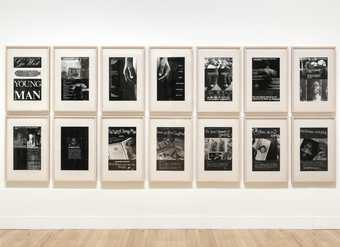
Not on display
- Artist
- Gilbert & George born 1943, born 1942
- Medium
- 16 photographs, gelatin silver print on paper with dye on paper mounted onto board
- Dimensions
- Displayed: 2424 × 2020 × 25 mm
- Collection
- ARTIST ROOMS Tate and National Galleries of Scotland
- Acquisition
- ARTIST ROOMS Acquired jointly with the National Galleries of Scotland through The d'Offay Donation with assistance from the National Heritage Memorial Fund and the Art Fund 2008
- Reference
- AR00174
Summary
Thirst is a work by Gilbert & George that depicts an exchange of bodily fluid in a cartoonish style. It consists of sixteen hand-coloured, individually framed photograms arranged to form a single image. The thin black lines of the frames create a four by four grid across the composition. Two penises extending from the lower edge of the image cross each other diagonally, and both are predominately black with a red glans. A yellow stream projects from each penis to be received orally by two heads that emerge from the upper two corners of the piece, their heads almost entirely black apart from blue eyes, white ears and a white hairline. Their open mouths are the same red as the two glans. The figures and their genitalia are surrounded by white space. The title and date of the work, in addition to the artists’ signatures, are printed in black ink in the bottom right panel.
From 1981 onwards the range of Gilbert & George’s visual repertoire expanded significantly with the introduction to their work of the photogram technique that was used to produce Thirst. To make such works the artists created stencils and laid them onto light-sensitive paper. By exposing it to light the image of the stencil became imprinted on the paper, onto which bright dyes were then selectively applied. The photograms were dry mounted onto thin board and framed in black-painted aluminium frames with Perspex glazing. When exhibited the framed works are hung on horizontal tracks.
The bold colours and simplified shapes of the photograms allowed Gilbert & George to engage directly with sexual themes. This was because, in the artists’ opinion, it tempered the effect of this sexual content through the playful nature of the constructed images:
We wanted to confront the viewers in a museum, as normally you don’t see this stuff, and make them accept it. It was done in a cartoon-like way because in reality they would never have been accepted at that time.
(Quoted in ‘Hunger’, National Galleries of Scotland, Edinburgh, https://www.nationalgalleries.org/art-and-artists/88829/hunger, accessed 18 January 2016.)
Thirst depicts a reciprocal exchange of bodily fluids as a fulfilling act. Art historian Wolf Jahn observes that Thirst ‘stresses thirst without necessarily implying a mutual act of drinking, and thus acquires an emblematic character which alludes to the thirst for sex in the abstract’ (Jahn 1989, p.330). Similarly, in Hunger 1982 (Tate AR00173), the oral reception of a penis can ultimately be assumed to alleviate a sexual desire as opposed to a craving based on nutritional needs. Despite this overtly sexual content, art historian Marco Livingstone argues that Gilbert & George avoid the pornographic, observing that in Thirst, ‘an exchange of body substances is portrayed as a sacramental act, one that transcends disgust, as it does in the sexual act itself’ (Marco Livingstone, ‘From the Heart’, in Tate Modern 2007, p.20). Art historian Bernard Marcadé further argues that this use of explicit imagery was not intended to offend, but instead that their inclusion of bodily fluids and, later, faeces and defecation is a result of the artists’ attempt to depict a brutally honest examination of life, one which includes the body’s natural processes (Bernard Marcadé, Gilbert & George, exhibition catalogue, Muse´e d’Art Moderne de la Ville de Paris, Paris 1997, p.256). This statement fits well with Gilbert & George’s claim, put forward in their 1986 declaration ‘What Our Art Means’, that: ‘We want to find and accept all the good and bad in ourselves … We want to spill our blood, brains and seed in our life-search for new meanings and purpose to give to life’ (Gilbert & George in Ratcliff 1986, p.vii).
In conjunction with Thirst, Gilbert & George created the works Hunger and Sperm Eaters 1982 (Tate Modern 2007, reproduced p.92). In addition to having similar formal qualities, these works engage with the oral reception of male genitalia and its excretions. Hunger looks at reciprocal fellatio and Sperm Eaters depicts male ejaculation. While scatological content had been previously implied or referenced in Gilbert & George’s work before this point, it had not been so openly displayed (see, for instance, George the Cunt and Gilbert the Shit 1969, Tate AR00170). The use of photograms not only allowed the artists to present gallery audiences with sexual imagery, but also, more significantly, with homosexual imagery. Thirst was created only fifteen years after homosexual acts were decriminalised in the UK. Gilbert & George have discussed the abuse they faced living in London as openly gay men during this period. In a 1974 interview with writer Gordon Burn, Gilbert explained that ‘It was the time of the queer-bashing’ (‘Gilbert & George: Interview with Gordon Burn’, reproduced in Hans-Ulrich Obrist and Robert Violette (eds.), The Words of Gilbert & George, London 1997, p.72). Thirst simultaneously speaks of social progress and the continued challenges that were faced by the gay community.
Further reading
Carter Ratcliff, Gilbert & George: The Complete Pictures, 1971–1985, exhibition catalogue, CAPC Musée d’Art Contemporain de Bordeaux, Bordeaux 1986, reproduced p.184.
Wolf Jahn, The Art of Gilbert & George, London 1989, reproduced p.338.
Gilbert & George: Major Exhibition, exhibition catalogue, Tate Modern, London 2007, reproduced p.91.
Daisy Silver
The University of Edinburgh
January 2016
The University of Edinburgh is a research partner of ARTIST ROOMS.
Does this text contain inaccurate information or language that you feel we should improve or change? We would like to hear from you.
Display caption
‘We are driven by everything that is slightly taboo, by the forbidden.’ Sexuality is a central theme of Gilbert & George’s work, which is explored in images that are often provocative and disconcerting. Hunger and Thirst show a sexual act that is depicted in a cartoon-like, almost diagrammatic, manner. The artists have commented on these works: ‘we wanted to confront the viewers in a museum, as normally you don’t see this stuff, and make them accept it. It was done in a cartoon like way because in reality they would never have been accepted at that time’.
Gallery label, February 2010
Does this text contain inaccurate information or language that you feel we should improve or change? We would like to hear from you.
Explore
- emotions, concepts and ideas(16,416)
-
- formal qualities(12,454)
-
- cartoon / comic strip(177)
- diagrammatic(799)
- symmetry(220)
- actions: processes and functions(2,161)
-
- urinating(11)
- man(10,453)
- head / face(2,497)
- sexual organs(178)
- urine(4)
- sex and relationships(833)
-
- homosexuality(1,673)
- sex(557)
You might like
-
Gilbert & George Fallen Leaves
1980 -
Gilbert & George Hunger
1982 -
Gilbert & George Family Tree
1991 -
Gilbert & George Faith Drop
1991 -
Gilbert & George Light Headed
1991 -
Gilbert & George Existers
1984 -
Gilbert & George England
1980 -
Gilbert & George Death Hope Life Fear
1984 -
Gilbert & George Red Morning Trouble
1977 -
Gilbert & George Happy
1980 -
Gilbert & George Deatho Knocko
1982 -
Gilbert & George Cunt Scum
1977 -
Gilbert & George Naked Eye
1994 -
Gilbert & George Named
2001 -
Keith Piper Go West Young Man
1987

